高中英语构词法教案电子教案
- 格式:doc
- 大小:49.50 KB
- 文档页数:9
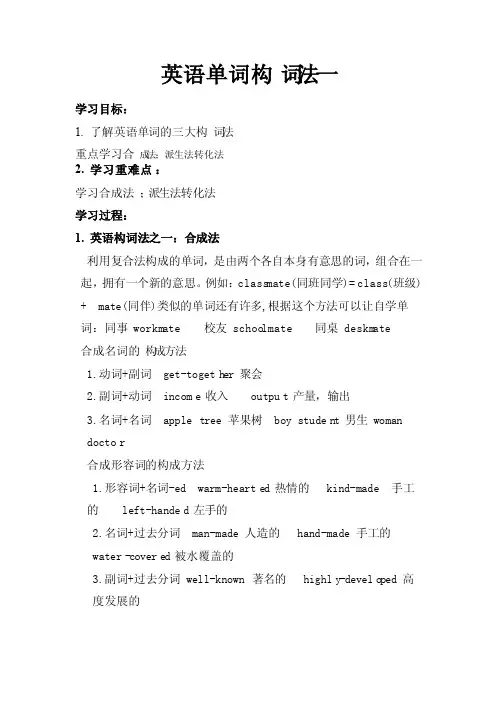
英语单词构词法一学习目标:1.了解英语单词的三大构词法重点学习合成法;派生法转化法2.学习重难点:学习合成法;派生法转化法学习过程:1.英语构词法之一:合成法利用复合法构成的单词,是由两个各自本身有意思的词,组合在一起,拥有一个新的意思。
例如:classm ate(同班同学)= class(班级) + mate(同伴)类似的单词还有许多,根据这个方法可以让自学单词:同事 workma te 校友 school mate同桌 deskma te合成名词的构成方法1.动词+副词 get-togeth er 聚会2.副词+动词 income收入 output产量,输出3.名词+名词 appletree 苹果树 boy studen t 男生 womandoctor合成形容词的构成方法1.形容词+名词-ed warm-hearte d 热情的 kind-made 手工的 left-handed左手的2.名词+过去分词 man-made 人造的 hand-made 手工的water-covere d 被水覆盖的3.副词+过去分词 well-known著名的 highly-develo ped 高度发展的4.形容词+现在分词 good-lookin g 漂亮的 easy-going随和的5. 副词+现在分词 hard-workin g 辛劳的2.英语构词法之二:派生法形象地说“派生法”就是从一个单词引申出另外一个新词。
学生也会发现许多单词加一些词缀就成了另一个词,什么叫词缀呢?1.前缀除少数英语前缀外,前缀一般改变单词的意义,不改变词性;英语后缀一般改变词类,而不引起词义的变化2.后缀后缀通常会改变单词的词性,构成意义相近的其他词性;少数后缀还会改变词义,变为与原来词义相反的新词。
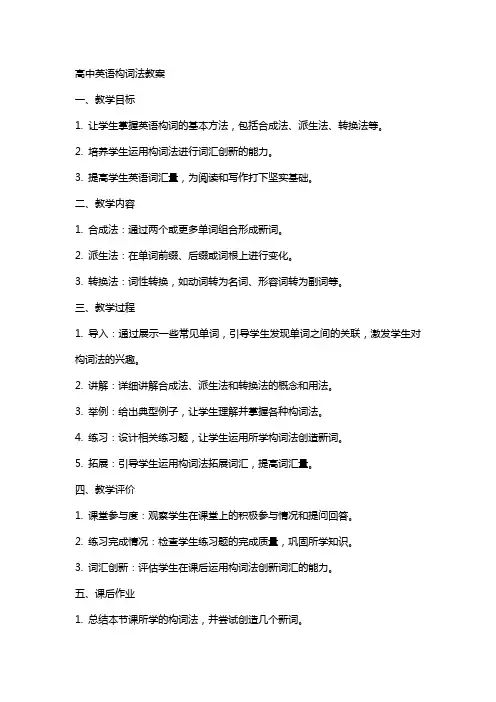
高中英语构词法教案一、教学目标1. 让学生掌握英语构词的基本方法,包括合成法、派生法、转换法等。
2. 培养学生运用构词法进行词汇创新的能力。
3. 提高学生英语词汇量,为阅读和写作打下坚实基础。
二、教学内容1. 合成法:通过两个或更多单词组合形成新词。
2. 派生法:在单词前缀、后缀或词根上进行变化。
3. 转换法:词性转换,如动词转为名词、形容词转为副词等。
三、教学过程1. 导入:通过展示一些常见单词,引导学生发现单词之间的关联,激发学生对构词法的兴趣。
2. 讲解:详细讲解合成法、派生法和转换法的概念和用法。
3. 举例:给出典型例子,让学生理解并掌握各种构词法。
4. 练习:设计相关练习题,让学生运用所学构词法创造新词。
5. 拓展:引导学生运用构词法拓展词汇,提高词汇量。
四、教学评价1. 课堂参与度:观察学生在课堂上的积极参与情况和提问回答。
2. 练习完成情况:检查学生练习题的完成质量,巩固所学知识。
3. 词汇创新:评估学生在课后运用构词法创新词汇的能力。
五、课后作业1. 总结本节课所学的构词法,并尝试创造几个新词。
2. 收集日常生活中遇到的构词法例子,进行分析和学习。
3. 下周课堂上分享自己创造的新词和学习的构词法例子。
六、教学策略1. 采用互动式教学,鼓励学生积极参与,提高课堂氛围。
2. 通过实例分析,让学生直观地理解构词法。
3. 设计多样化的练习题,巩固所学知识。
4. 引导学生进行小组讨论,培养合作学习意识。
5. 定期进行词汇创新比赛,激发学生学习兴趣。
七、教学资源1. 课件:制作精美课件,展示各种构词法实例。
2. 练习题:设计具有针对性的练习题,巩固所学知识。
3. 词汇卡片:制作词汇卡片,方便学生随时复习。
4. 网络资源:利用网络资源,拓展学生视野,提高词汇量。
八、教学难点1. 合成法的词义辨析:区分由合成法形成的新词与原词义的区别。
2. 派生法的词缀识别:识别单词中的前缀、后缀,理解其变化规律。
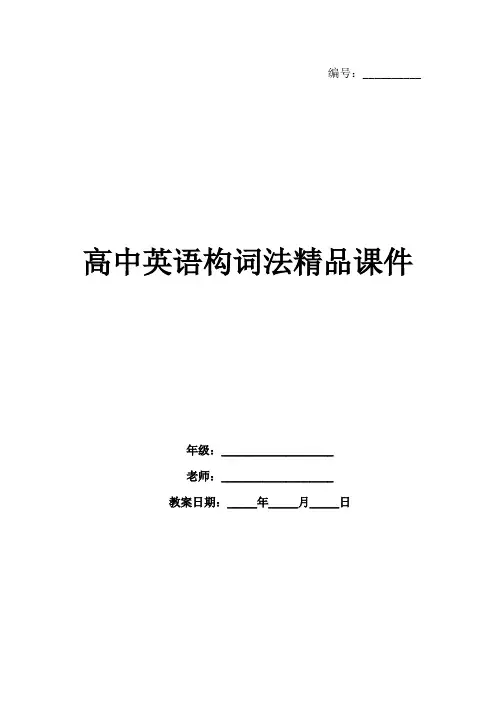
编号:__________ 高中英语构词法精品课件年级:___________________老师:___________________教案日期:_____年_____月_____日高中英语构词法精品课件目录一、教学内容1.1 构词法的基本概念1.2 词根、前缀和后缀1.3 合成词和派生词1.4 词类转换1.5 实例分析二、教学目标2.1 知识与技能2.2 过程与方法2.3 情感态度与价值观三、教学难点与重点3.1 难点3.2 重点四、教具与学具准备4.1 教具4.2 学具五、教学过程5.1 导入5.2 新课导入5.3 课堂活动5.4 练习与巩固六、板书设计6.1 构词法基本概念板书6.2 词根、前缀和后缀板书6.3 合成词和派生词板书6.4 词类转换板书6.5 实例分析板书七、作业设计7.1 作业内容7.2 作业要求7.3 作业评价八、课后反思8.1 教学效果评价8.2 教学方法改进8.3 学生反馈与改进措施九、拓展及延伸9.1 相关知识点拓展9.2 构词法在实际应用中的拓展9.3 构词法相关练习与活动教案如下:一、教学内容构词法是英语学习中的重要组成部分,它包括词根、前缀和后缀,合成词和派生词,以及词类转换等。
通过学习构词法,学生可以更好地理解和运用英语单词,扩大词汇量,提高语言表达能力。
二、教学目标(一)知识与技能1. 学生能够理解构词法的基本概念。
2. 学生能够区分和运用词根、前缀和后缀。
3. 学生能够识别和创造合成词和派生词。
4. 学生能够灵活运用词类转换。
(二)过程与方法1. 学生通过实例分析,掌握构词法的应用。
2. 学生通过课堂活动,提高英语听说读写能力。
(三)情感态度与价值观1. 学生培养对英语学习的兴趣。
2. 学生树立正确的语言学习观念。
三、教学难点与重点(一)难点1. 构词法的理解和运用。
2. 合成词和派生词的识别和创造。
(二)重点1. 词根、前缀和后缀的掌握。
2. 词类转换的运用。
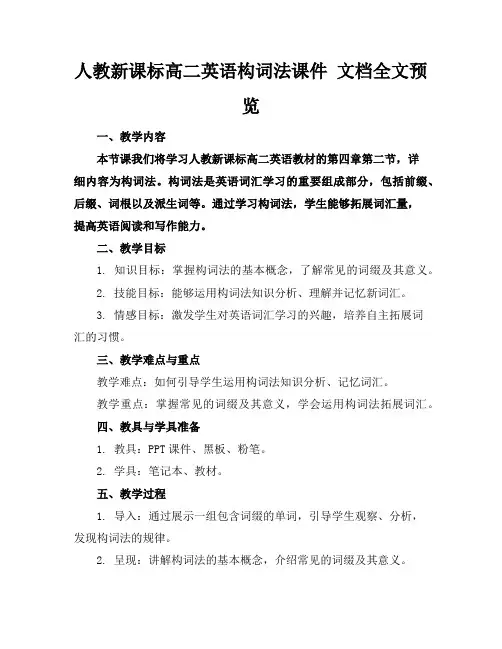
人教新课标高二英语构词法课件文档全文预览一、教学内容本节课我们将学习人教新课标高二英语教材的第四章第二节,详细内容为构词法。
构词法是英语词汇学习的重要组成部分,包括前缀、后缀、词根以及派生词等。
通过学习构词法,学生能够拓展词汇量,提高英语阅读和写作能力。
二、教学目标1. 知识目标:掌握构词法的基本概念,了解常见的词缀及其意义。
2. 技能目标:能够运用构词法知识分析、理解并记忆新词汇。
3. 情感目标:激发学生对英语词汇学习的兴趣,培养自主拓展词汇的习惯。
三、教学难点与重点教学难点:如何引导学生运用构词法知识分析、记忆词汇。
教学重点:掌握常见的词缀及其意义,学会运用构词法拓展词汇。
四、教具与学具准备1. 教具:PPT课件、黑板、粉笔。
2. 学具:笔记本、教材。
五、教学过程1. 导入:通过展示一组包含词缀的单词,引导学生观察、分析,发现构词法的规律。
2. 呈现:讲解构词法的基本概念,介绍常见的词缀及其意义。
3. 示范:以单词“transport”为例,展示如何运用构词法记忆相关词汇。
4. 实践:学生分组讨论,运用构词法分析给定单词,并在课堂上分享。
5. 巩固:进行随堂练习,检测学生对构词法的掌握程度。
六、板书设计1. 构词法概念2. 常见词缀及其意义3. 构词法记忆技巧4. 随堂练习答案七、作业设计(1) happy(3) success2. 答案:(1) happiness, unhappiness, happily(3) successful, successively, unsuccessful八、课后反思及拓展延伸1. 反思:本节课学生参与度较高,但仍有个别学生未能完全掌握构词法知识,需要在课后进行个别辅导。
重点和难点解析1. 教学目标中的技能目标:能够运用构词法知识分析、理解并记忆新词汇。
2. 教学难点:如何引导学生运用构词法知识分析、记忆词汇。
3. 教学过程中的实践环节:学生分组讨论,运用构词法分析给定单词。
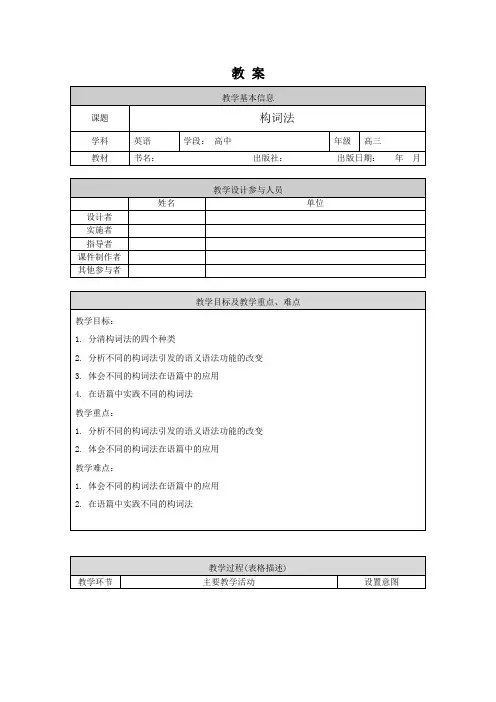
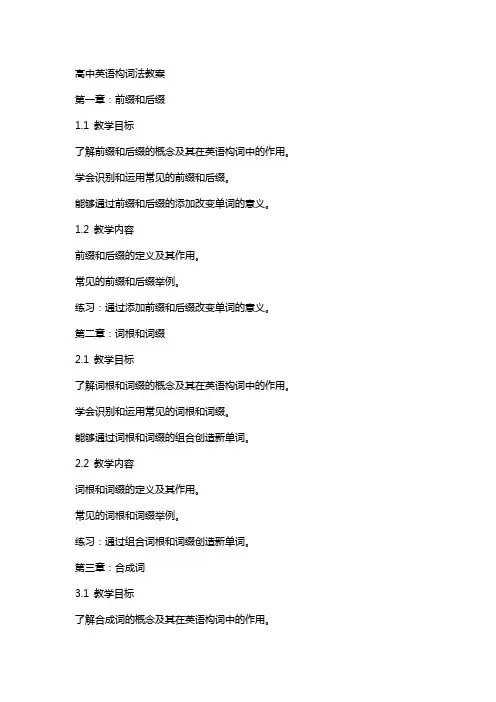
高中英语构词法教案第一章:前缀和后缀1.1 教学目标了解前缀和后缀的概念及其在英语构词中的作用。
学会识别和运用常见的前缀和后缀。
能够通过前缀和后缀的添加改变单词的意义。
1.2 教学内容前缀和后缀的定义及其作用。
常见的前缀和后缀举例。
练习:通过添加前缀和后缀改变单词的意义。
第二章:词根和词缀2.1 教学目标了解词根和词缀的概念及其在英语构词中的作用。
学会识别和运用常见的词根和词缀。
能够通过词根和词缀的组合创造新单词。
2.2 教学内容词根和词缀的定义及其作用。
常见的词根和词缀举例。
练习:通过组合词根和词缀创造新单词。
第三章:合成词3.1 教学目标了解合成词的概念及其在英语构词中的作用。
学会识别和运用常见的合成词。
能够通过合成词的构成方式创造新单词。
3.2 教学内容合成词的定义及其作用。
常见的合成词举例。
练习:通过合成词的构成方式创造新单词。
第四章:派生词4.1 教学目标了解派生词的概念及其在英语构词中的作用。
学会识别和运用常见的派生词。
能够通过派生词的构成方式改变单词的意义。
4.2 教学内容派生词的定义及其作用。
常见的派生词举例。
练习:通过派生词的构成方式改变单词的意义。
第五章:反义词和同义词5.1 教学目标了解反义词和同义词的概念及其在英语构词中的作用。
学会识别和运用常见的反义词和同义词。
能够正确使用反义词和同义词表达相反或相似的意义。
5.2 教学内容反义词和同义词的定义及其作用。
常见的反义词和同义词举例。
练习:通过反义词和同义词的正确使用表达相反或相似的意义。
第六章:转换词类6.1 教学目标了解英语中词类的转换及其在句子中的运用。
学会将名词、动词、形容词转换为其他词类。
能够运用转换词类丰富句子的表达。
6.2 教学内容英语中常见的词类转换方式。
转换词类的实例分析。
练习:将给出的单词转换为不同的词类并在句子中运用。
第七章:复合词7.1 教学目标理解复合词的概念及其在英语构词中的重要性。
学会识别和使用常见的复合词。

Book 4 Unit 5 Theme Parks Grammar -------Word FormationTeaching aim:1.Help the students master some common basic rules of word formation.;2. Guess the meaning of words through word formation and try to create news words using therules of word formation;3. To stimulate the students’ interest in English and promote their confidence in Englishlearning.Teaching key points:To master some common basics rules of word formationTeaching difficult points:To use the rules of word formation properly and freelyTeaching methods:Cooperation, self-learning, teamwork, explanation.Teaching ProcessI.Lead InPlay a short video From Transformers and show the formation of the word “transformer”II.Basic types of word formation: Compounding, Conversion, Derivation, Abbreviation Show the students some fashionable expressions from the Internet and Introduce the basic types of word formation, e.g.:(a) gaofu handsome, baifu beauty, leftover ladies, group purchase, Daddy-is-the-key,time-travel TV series(b) keep calm /calm down, shock sb. / in shock(c) envious, jealous and hateful, overseas returnee(d) DIY(do it yourself), AA(all apart)III.Self-study: AbbreviationWorld Trade Organization----- WTOThe United Kingdom ------__________________The United Nations ------ ______________mathematics -----------__________________IV.Cooperation and Probe: Compounding, Conversion, Derivationpounding合成动词 overcome,oversleep,sleepwalk,______________________合成形容词snow-white, man-made, English-speaking, warm-hearted, hard-working, five-year-old. seven-day, ______________________________________合成副词 however, anywhere, downstairs, ___________________________________合成代词something; everything; nobody; someone; anybody合成名词 seafood, reading room , passer-by, grown-up, policeman, woman doctor思考:passer-by, grown-up, policeman, woman doctor 复数怎么变?B.Conversion: 判断下列划线部分的词性并说出其构词法a. 1. It tastes good.2. It has a good taste.b. 1. Let’s go hand in hand.2. Please hand in your exercise books after class.c. 1. Her room is clean and tidy.2. She cleans her room every day.d. 1. Let’s go out for a walk.2. He is walking in the street.C. Derivationa. prefix(前缀),通常只引起词义变化,不改变词性1. 表否定意义的前缀常有dis-, in-, mis-, non-, un-等,在单词前面加这类前缀常构与该词意义相反的新词。
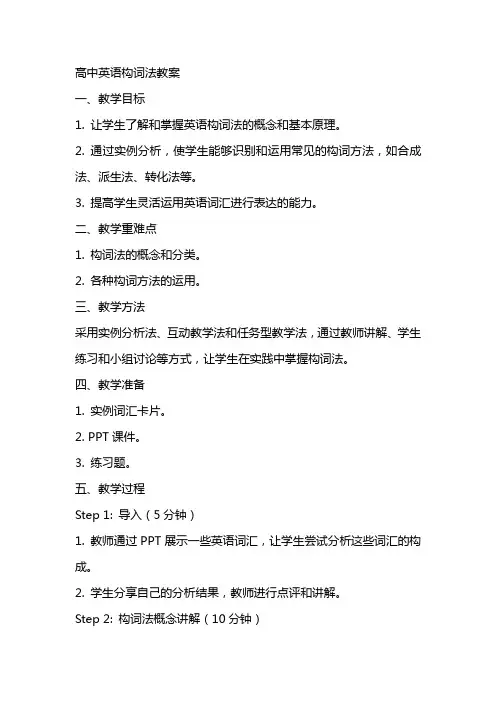
高中英语构词法教案一、教学目标1. 让学生了解和掌握英语构词法的概念和基本原理。
2. 通过实例分析,使学生能够识别和运用常见的构词方法,如合成法、派生法、转化法等。
3. 提高学生灵活运用英语词汇进行表达的能力。
二、教学重难点1. 构词法的概念和分类。
2. 各种构词方法的运用。
三、教学方法采用实例分析法、互动教学法和任务型教学法,通过教师讲解、学生练习和小组讨论等方式,让学生在实践中掌握构词法。
四、教学准备1. 实例词汇卡片。
2. PPT课件。
3. 练习题。
五、教学过程Step 1: 导入(5分钟)1. 教师通过PPT展示一些英语词汇,让学生尝试分析这些词汇的构成。
2. 学生分享自己的分析结果,教师进行点评和讲解。
Step 2: 构词法概念讲解(10分钟)1. 教师讲解构词法的定义和分类,如合成法、派生法、转化法等。
2. 学生跟随教师一起分析一些典型词汇,理解各种构词法的特点。
Step 3: 实例分析(15分钟)1. 教师展示实例词汇卡片,让学生尝试运用所学的构词法进行分析。
2. 学生分组讨论,分享分析结果,教师进行点评和讲解。
Step 4: 练习与巩固(10分钟)1. 学生完成练习题,运用所学的构词法进行词汇创作。
2. 教师选取部分学生的作品进行展示和点评。
Step 5: 课堂小结(5分钟)1. 教师引导学生总结本节课所学内容,巩固构词法的知识。
2. 学生分享自己的学习收获和感悟。
Step 6: 课后作业(课后自主完成)1. 学生运用所学的构词法,创作一首英文小诗。
2. 教师批改作业,给予评价和建议。
六、教学拓展1. 引导学生关注构词法在实际语境中的应用,提高学生的语言感知能力。
2. 通过阅读和听力练习,让学生接触更多运用构词法创作的词汇和句子。
七、教学评价1. 课后收集学生的英语小诗,对学生的创作进行评价。
2. 在下一节课开始时,让学生分享自己的作业成果,互相学习和交流。
八、教学反馈与调整1. 根据学生的作业表现和课堂反馈,了解学生对构词法的掌握情况。
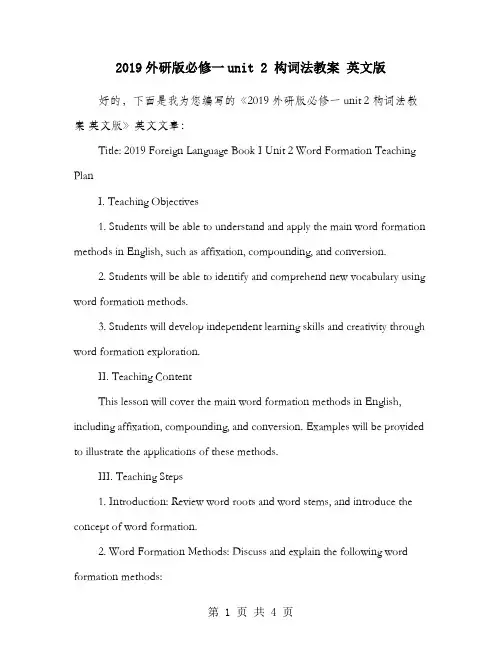
2019外研版必修一unit 2 构词法教案英文版好的,下面是我为您编写的《2019外研版必修一unit 2 构词法教案英文版》英文文章:Title: 2019 Foreign Language Book I Unit 2 Word Formation Teaching PlanI. Teaching Objectives1. Students will be able to understand and apply the main word formation methods in English, such as affixation, compounding, and conversion.2. Students will be able to identify and comprehend new vocabulary using word formation methods.3. Students will develop independent learning skills and creativity through word formation exploration.II. Teaching ContentThis lesson will cover the main word formation methods in English, including affixation, compounding, and conversion. Examples will be provided to illustrate the applications of these methods.III. Teaching Steps1. Introduction: Review word roots and word stems, and introduce the concept of word formation.2. Word Formation Methods: Discuss and explain the following word formation methods:a. Affixation: Adding prefixes or suffixes to word roots or stems to change the meaning or form of the word.b. Compounding: Making new words by combining two or more existing words.c. Conversion: Changing the form of an existing word to a different part of speech.3. Example-Based Learning: Provide examples of each word formation method, and have students identify and explain the underlying principles.4. Practice: Assign reading passages or vocabulary lists, and have students identify and use words formed using the various word formation methods.5. Group Discussions: Encourage students to discuss their findings and share examples of word formation they have encountered in their own reading or language use.6. Review and Summary: Review the main points covered in the lesson, and summarize key word formation concepts and strategies.7. Homework: Have students further practice with word formation methods, and suggest additional resources for further exploration.IV. Teaching Strategies1. Use visual aids and examples to illustrate the principles of word formation, making it easier for students to understand.2. Provide ample practice with real vocabulary lists and reading passages to ensure students can apply their newfound knowledge.3. Encourage students to be creative and come up with their own examples of word formation, fostering independent learning skills.4. Provide feedback and positive reinforcement to encourage students’ participation and successes.V. Learning ObjectivesAt the end of the lesson, students should be able to:1. Identify and explain the main word formation methods in English, including affixation, compounding, and conversion.2. Recognize and use words formed using these methods in reading passages and vocabulary lists.3. Develop independent learning skills and creativity through exploration of word formation principles.VI. Assessment Plan1. Assign a quiz or test to assess students’ understanding of the main concepts covered in the lesson.2. Incorporate student work into the final grade, giving appropriate credit for participation, creativity, and application of word formation strategies.3. Provide individual or group feedback on any areas that need further clarification or improvement.VII. Additional Resources1. Recommended additional reading materials and online resources for further exploration of word formation principles and applications.2. Practice exercises and quizzes to reinforce students’ understanding of the lesson content.。
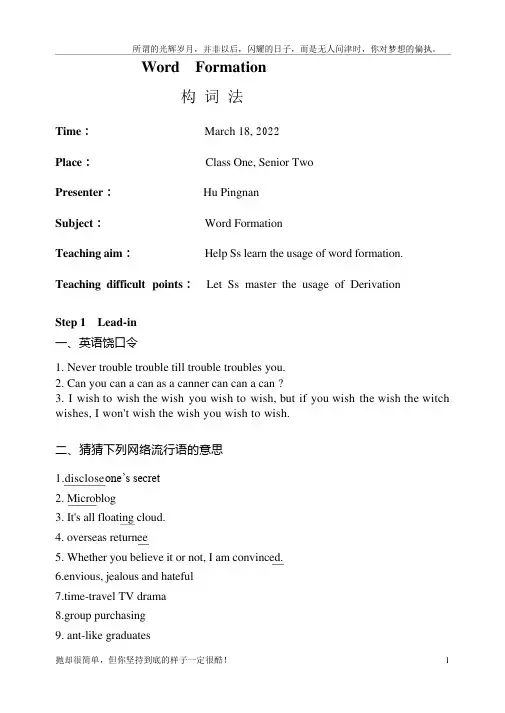
Word Formation构词法Time:March 18, 2022Place:Class One, Senior TwoPresenter:Hu PingnanSubject:Word FormationTeaching aim:Help Ss learn the usage of word formation. Teaching difficult points:Let Ss master the usage of DerivationStep 1 Lead-in一、英语饶口令1. Never trouble trouble till trouble troubles you.2. Can you can a can as a canner can can a can ?3. I wish to wish the wish you wish to wish, but if you wish the wish the witch wishes, I won't wish the wish you wish to wish.二、猜猜下列网络流行语的意思1.disclose o ne’s secret2. Microblog3. It's all floating cloud.4. overseas returnee5. Whether you believe it or not, I am convinced.6.envious, jealous and hateful7.time-travel TV drama8.group purchasing9. ant-like graduates10. a tear-inducing misery11. daddy-is-the-key12. leftover ladies13. in shock /shock sb14. keep calm /calm down三、构词法主要类型派生法(Derivation)able →unable; teach→teacher 构合成法(Compounding)space+ship →spaceship词转化法(Conversion)visit v. →visit n.法缩略法(Abbreviation)Do it yourself. →DIYStep 2 合成词Compound一.合成名词例词:构成方式seafood 名词/代词+名词greenhouse 形容词+名词handwriting 名词+动名词(V-ing)waiting – room 动名词+名词pain – killer 名词+动词(er/or) pickpocket 动词+名词turn – off 动词+副词output 副词+动词afternoon 介词/副词+名词二.合成动词overcome 副词+动词whitewash 形容词+动词sleepwalk; 名词+动词三.合成形容词例词构成方式snow-white 名词+形容词English-speaking 名词+现在分词man-made 副词+过去分词high-class; 形容词+过去分词light-blue 形容词+形容词good-looking 形容词+现在分词warm-hearted 形容词+名词+edsecond-hand 数词+名词hard-working 副词+现在分词well-known 副词+过去分词underground 介词+名词四、合成副词however 副词+副词anywhere; whatever 代词+副词downstairs; upstairs 副词+名词anyway 形容词+名词五.合成代词something; everything; nobody; someone; anybody构成方式:some/any/no+thing/one/bodyStep 3 转化法(Conversion)taste v._______ It tastes very good.n. _______ It has a good taste.hand n. _______ We always walk hand in hand.v. _______ Please hand me the book.wrong adj. _______There is something wrong with the car.n. _______ He didn’t know the dif ference between right and wrong . clean adj. _______Please keep tidy and clean.v. _______You have to clean the blackboard after class.指出下列划下线单词的词性1. Jim dreams of being the best football player in England.2. Please stop here, and it is the bus stop3. The coach was questioning the team members about their practice conditions4. Who’s guarding that building?5. The car slowed down to half its speed6. Don’t use too cold water to water flowers7. The old in our village are living a happy life.Step 4 派生法Derivation前缀否定前缀派其它前缀生名词后缀法后缀形容词后缀副词后缀动词后缀表示否定和相反意义的前缀有:_____________________________________________________________. 前缀例子un- unhappy(不高兴)unlock(开锁)dis- dislike(不喜欢)disagree(不允许)im- impossible(不可能的)improper(不合适的)in- informal(非正式的)incorrect(不正确的)ir- irregular(不规则的)irrelevant(不相关的)il- illegal(不合法的)illogical(不合理的)表示其他意思的前缀前缀意义例子re- 重新,再次regain(再次获得)reform(改革)mis- 错误的misunderstand(误解)mislead(误导)anti- 反、防anti-tank(反坦克的)anti-social(危害社会的)ex- 前ex-president(前总统)ex-wife (前妻)pre- 预先preview(预习)predict (预言、预测)post- 之后的post-war(战后的)postgraduate(研究生)fore- 之前的forecast(预报)foresee(预见)super- 超级;上层supermarket(超市)superman(超人)sub- 下面的;亚、subway(地下铁道)subtitle(副标题)次inter- 之间的,互相interact(相互作用)international(国际的)前缀意义例子trans- 跨越;移transport(运输)translate(翻译)semi- 半semi-final(半决赛)semiconductor(半导体)vice- 副vice-premier(副总理)vice-chairman(副主席)uni- 单uniform(征服)unicycle(单轮车)bi- 双bicycle(自行车)bimonthly(双月的)multi- 多multinational(多国的)multicolor(多色的)auto- 自动,自主automation(自动化)automobile(汽车)后缀法1. 名词后缀1)构成表示人或者物的名词的常用后缀有:____________________________________________________________________________.后缀例子-or/er thinker(思想家)builder(建设者)translator(翻译者)-ist physicist(物理学家)dentist(牙科医生)typist(打字员)-ee employee(雇员)trainee (受训人员)interviewee(被采访者)-(i)an physician(内科医生)Italian (意大利人)American(美国人)-ese Chinese (中国人)Japanese(日本人)Vietnamese(越南人)-ant assistant(助手)contestant(竞争者)servant(仆人)2) 构成表示行为、性质、状态等抽象名词的常用后缀有:____________________________________________________________________________ ____________________________________________________________________________.后缀例子-al arrival(到达)refusal(拒绝)survival(幸存)-ance/-ence acceptance(接受)assistance (匡助)dependence(依靠)-tion/-sion discussion(讨论)preparation(准备)repetition (重复)-ics physics (物理学)economics(经济学)politics (政治学)-ing building (建造物)wedding (婚礼)learning (学习,学问)-ty reality (现实)ability (能力)difficulty(艰难)-ment argument (争论)settlement(解决)establishment(建立)-ness greatness (伟大)hardness (硬度)kindness(善良)-th warmth (温暖)length (长度)growth(成长)-ure failure (失败)pressure (压力)mixture (混合物)-ship friendship(友谊)leadership(领导)relationship(关系)2.构成形容词的常用后缀有:____________________________________________________________________________ ____________________________________________________________________________后缀例子-able/-ible suitable(适合的)responsible(负责的)acceptable(可接受的)-al natural(天然的)national(国家的)personal (个人的)-ful powerful(强大faithful(忠诚的)colorful (多彩的)的)-less fearless(无畏的)useless(无用的)helpless (无助的)后缀例子-ish selfish(自私的)childish(幼稚的)bookish (书呆子气的)-ive collective(集体的)decisive(决定性的)native (本国的)delicious (可口的)-ous famous(著名的)continuous(连续不断的)scientific(科学的)electronic (电子的)-ic historic(有历史意义的)-ly friendly(友好的)lively(活泼的)lovely (可爱的)-(t)y thirsty(口渴的)noisy(喧闹的)healthy (健康的)-ent/-ant pleasant(令人愉快的)dependent(依赖的)different (不同的)-ary secondary(次要的)imaginary(想象中的)ordinary (普通的)-en golden(金色的)wooden(木制的)woolen (毛纺的)3. 构成副词的常用后缀有:___________________________________________________。
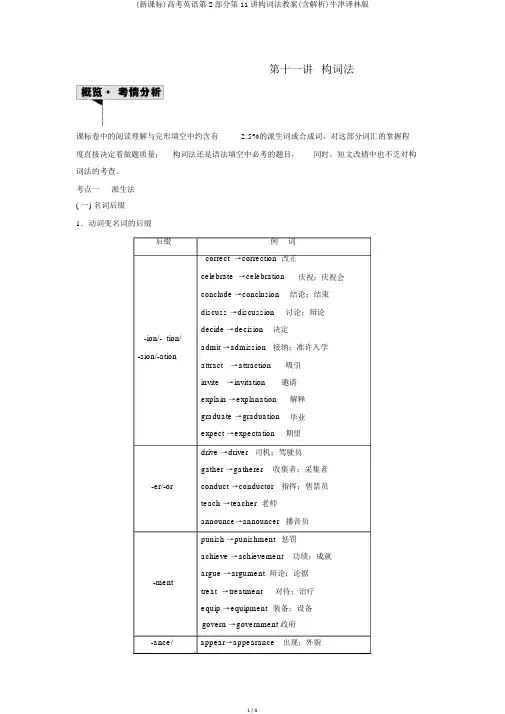
第十一讲构词法课标卷中的阅读理解与完形填空中约含有 2.5%的派生词或合成词,对这部分词汇的掌握程度直接决定着做题质量;构词法还是语法填空中必考的题目,同时,短文改错中也不乏对构词法的考查。
考点一派生法( 一) 名词后缀1.动词变名词的后缀后缀例词correct →correction改正celebrate →celebration 庆祝;庆祝会conclude →conclusion 结论;结束discuss →discussion 讨论;辩论-ion/- tion/decide →decision 决定admit →admission 接纳;准许入学-sion/-ationattract →attraction 吸引invite →invitation 邀请explain →explanation 解释graduate →graduation 毕业expect →expectation 期望drive →driver 司机;驾驶员gather →gatherer 收集者;采集者-er/-or conduct →conductor 指挥;售票员teach →teacher 老师announce→announcer 播音员punish →punishment 惩罚achieve →achievement 功绩;成就-ment argue →argument 辩论;论据treat →treatment 对待;治疗equip →equipment 装备;设备govern →government 政府-ance/appear→appearance出现;外貌-ence guide →guidance 指引;指导perform →performance 表演;节目exist →existence 存在;生存prefer →preference 偏爱refer →reference 参考;查阅-ing hear →hearing 听力;听觉begin →beginning 开始fail →failure 失败;没做到-ure press →pressure 压力-ture mix→mixture 混合;混合物depart →departure 离开;出发-y recover →recovery 恢复;痊愈discover →discovery 发现choose→choice 选择其他vary →variety 多样化;种类tend →tendency 趋向;趋势2. 形容词变名词的后缀后缀例词-age short →shortage 不足;短缺efficient →efficiency效率;功效-cy fluent →fluency 流利;流畅accurate →accuracy 准确性private →privacy 隐私;私密-domfree →freedom 自由;自主wise →wisdom 明智;智慧-encedifferent →difference 差异silent →silence 沉默weak→weakness 虚弱;弱点-ness kind →kindness 仁慈;好意careless →carelessness 粗心大意-th strong →strength 力气;强项warm→warmth 温暖;热情-y/ honest →honesty 诚实-ty/ difficult →difficulty 困难-ity cruel →cruelty 残酷;残暴safe →safety 安全disable →disability 无能;伤残responsible →responsibility责任( 二 ) 形容词、副词后缀1.动词、名词变形容词的常见后缀后缀例词accept →acceptable 可接受的comfort →comfortable 舒适的-able fashion →fashionable 时髦的suit →suitable 合适的reason →reasonable 有道理的music→musical 音乐的origin →original 最初的-al person →personal 个人的;私人的center →central 中央的;中心的nature →natural 自然的;天生的doubt →doubtful 怀疑的forget →forgetful 健忘的-ful harm→harmful 有害的hope→hopeful 有希望的peace→peaceful 和平的-ed scare →scared 感到恐惧的confuse →confused 感到困惑的surprise →surprising 令人惊异的-ing convince →convincing 令人信服的satisfy →satisfying 令人满意的access→accessible 容易取得的-ible horror →horrible 可怕的;恐怖的terror →terrible 可怕的-iveact →active 积极的;活跃的effect →effective 有效的;生效的attract →attractive 有吸引力的impress →impressive 给人深刻印象的continue →continuous 不断的;持续的anxiety →anxious 忧虑的- ous caution →cautious 十分小心的;谨慎的curiosity →curious 好奇的humor→humorous 幽默的-some tire →tiresome 令人厌倦的trouble →troublesome 麻烦的taste →tasty 美味的;可口的-y health →healthy 健康的wealth →wealthy 富裕的;丰富的-ern east →eastern 东方的;向东的child →childish 孩子气的- ish fool →foolish 愚蠢的;可笑的self →selfish 自私的2. 形容词变副词的后缀在形容词后加直接加 -ly改 y 为-ily去 e 加-ly( 三 ) 形容词、名词变动词的前缀和后缀-ly 可变成相应意义的副词slow 慢的→ slowlyhappy 高兴的→ happilytrue真的→ truly缓慢地高兴地真地前/后缀例词前缀en-able →enable 使能够large →enlarge扩大rich →enrich 使充实broad →broaden ( 使 ) 变宽ripe →ripen (使)成熟-ensharp →sharpen 使尖锐后缀wide→widen 加宽class →classify把分类-ifyjust →justify证明正确simple →simplify简化apology →apologize道歉-izeemphasis→emphasize 强调( 四 ) 表示否定或相反意义的前缀和后缀前/ 后缀dis-前il-缀im-in-ir-前缀mis-un-后缀考点二转化法例词agree →disagree不同意advantage →disadvantage缺点legal →illegal不合法的logical→illogical不合逻辑的polite→impolite无礼的patient →impatient不耐烦的formal →informal非正式的convenient →inconvenient不方便的regular →irregular不规则的responsible →irresponsible不负责任的lead →mislead误导understand →misunderstand误解usual →unusual不寻常的willing→unwilling不愿意的-less,hope →hopeless绝望的end→endless没完没了的不改变词形,把一个词由一种词类转用为另一种词类的方法叫转化法。
高中英语构词法学习教案一、引言构词法是语言学中的重要分支之一,是研究词汇的形成与变化规律的学科。
在英语学习中,掌握构词法对于拓展词汇量、提高阅读和写作能力具有重要作用。
本教案旨在帮助高中英语学习者系统学习和掌握英语构词法,提高他们的词汇应用能力。
二、教学目标1. 了解构词法的基本概念和分类;2. 掌握常见的构词法规则和构词方法;3. 提高学生对于词根、前缀和后缀的辨识和应用能力;4. 培养学生的词汇扩展和语言表达的能力。
三、教学内容第一节构词法概述1. 什么是构词法2. 构词法的分类和意义第二节词根1. 词根的概念和作用2. 常见的词根及其派生词例举3. 如何利用词根解释词汇第三节前缀1. 前缀的定义和作用2. 常用的前缀及其意义解析3. 利用前缀改变词汇意义的例子第四节后缀1. 后缀的定义和作用2. 常见的后缀及其派生词解析3. 利用后缀改变词汇性质的例子第五节构词法拓展1. 组合词和混合词的形成2. 缩略词和非正式缩写词的应用四、教学方法1. 理论讲解和示范:通过展示构词法的基本概念和规则,引导学生理解构词法的分类和应用方式。
2. 语言练习和应用:通过词根、前缀和后缀的辨识和运用活动,让学生巩固和运用所学的构词法规则。
3. 合作学习和小组讨论:鼓励学生在小组内合作学习和互动讨论,分享彼此的构词法启示和经验。
五、教学过程第一节构词法概述1. 引导学生思考和讨论构词法的定义和作用;2. 解释构词法的分类和意义。
第二节词根1. 通过举例解释词根的概念和作用;2. 分发词根表格,引导学生寻找并解释其中的词根;3. 给出一些词根,让学生根据所学规则构造新的词汇。
第三节前缀1. 示范几个常见的前缀,并解释其意义;2. 配发练习题,要求学生根据前缀给出的意义填写相应的单词。
第四节后缀1. 解释后缀的概念和作用;2. 列举一些常用的后缀,并提供相应的派生词例子;3. 让学生互相交流,讨论使用后缀能够派生出的单词。
英语《英语构词法知识》课件一、教学内容本节课的教学内容选自人教版高中英语必修教材第五单元,主要讲解英语构词法知识。
内容包括:合成法、派生法、转化法三种构词方法的定义、特点及示例。
二、教学目标1. 学生能理解并掌握合成法、派生法、转化法三种构词方法的定义和特点。
2. 学生能够运用所学的构词法知识分析和创造新的词汇。
3. 学生能够在实际语境中正确运用所学的构词法,提高英语词汇运用能力。
三、教学难点与重点1. 教学难点:构词法在实际语境中的运用。
2. 教学重点:合成法、派生法、转化法三种构词方法的定义、特点及应用。
四、教具与学具准备1. 教具:多媒体课件、黑板、粉笔。
2. 学具:教材、笔记本、文具。
五、教学过程1. 情景引入:通过展示一组词汇,让学生观察并猜测它们之间的关系,引导学生发现构词法的存在。
2. 知识讲解:b. 派生法:在词根前加前缀或在词根后加后缀来构成新词,例如:un、dis、like、ness、tion。
c. 转化法:词性转换,例如:noun to verb(look→looke)、verb to noun(buy→buyer)。
3. 示例讲解:通过示例词汇,讲解三种构词方法的具体应用。
4. 随堂练习:让学生运用所学的构词法知识,创造新的词汇。
5. 课堂互动:学生分享自己创造的词汇,大家共同讨论其合理性和创新性。
六、板书设计板书内容:构词法知识派生法:在词根前加前缀或在词根后加后缀来构成新词转化法:词性转换七、作业设计1. 作业题目:运用所学的构词法知识,创造五个新词汇,并解释其含义。
2. 答案示例:a. downtime(名词):指工作或生活中的空闲时间。
b. unfair(形容词):不公平的。
c. booklover(名词):热爱阅读的人。
d. happyness(名词):幸福感。
e. actionmovie(名词):动作电影。
八、课后反思及拓展延伸1. 课后反思:本节课学生对构词法的理解和运用情况良好,但在实际语境中的应用仍有待提高。
高一英语构词法合成法教案Title: Teaching Plan for Word Formation in High School EnglishIntroduction:Word formation is an important aspect of English language learning, especially for high school students. Understanding how words are formed and the rules that govern their formation can greatly improve students' vocabulary and language skills. In this teaching plan, we will explore the concept of word formation and provide various activities and exercises to help high school students grasp this important aspect of English language learning.Objective:The main objective of this teaching plan is to help high school students understand the concept of wordformation and the various ways in which new words can be created in English. By the end of this lesson, students should be able to identify and understand the different word formation processes such as affixation, compounding, conversion, blending, and back-formation. They should also be able to apply this knowledge to expand their vocabulary and improve their language skills.Lesson Plan:1. Introduction to Word Formation:- Start the lesson by introducing the concept of word formation and explaining its importance in English language learning.- Provide examples of how new words are formed through processes such as affixation, compounding, conversion, blending, and back-formation.2. Affixation:- Explain the process of affixation, which involves adding prefixes or suffixes to a base word to create a new word.- Provide examples of words that are formed through affixation and ask students to identify the base word and the affixes.3. Compounding:- Discuss the process of compounding, which involves combining two or more words to create a new word.- Provide examples of compound words and ask students to identify the words that make up the compound and their meanings.4. Conversion:- Explain the process of conversion, which involves changing the grammatical category of a word without changing its form.- Provide examples of words that undergo conversion and ask students to identify the original and converted forms of the words.5. Blending:- Discuss the process of blending, which involves combining parts of two words to create a new word.- Provide examples of blended words and ask students to identify the words that make up the blend and their meanings.6. Back-formation:- Explain the process of back-formation, which involves creating a new word by removing a supposed affix from an existing word.- Provide examples of words that are formed through back-formation and ask students to identify the originaland derived forms of the words.7. Activities and Exercises:- Provide various activities and exercises to help students practice identifying and understanding word formation processes.- These activities may include matching exercises, fill-in-the-blank exercises, and creating new words using different word formation processes.8. Conclusion:- Summarize the main points of the lesson and reinforce the importance of understanding word formation in English language learning.- Encourage students to continue practicing and applying their knowledge of word formation to expand their vocabulary and improve their language skills.Conclusion:Understanding word formation is essential for high school students to improve their vocabulary and language skills. By providing a comprehensive overview of word formation processes and engaging students in various activities and exercises, this teaching plan aims to help students grasp this important aspect of English language learning. With a solid understanding of word formation, students will be better equipped to expand their vocabulary and communicate effectively in English.。
英语构词法2016.9.241. 英语词性的分类及用法词类又叫词性,英语单词根据其在句子中的功能,可以分为十个大类:• 1. 名词noun n. apple苹果• 2. 代词pronoun pron. You你• 3. 形容词adjective adj. beautiful漂亮的• 4. 副词adverb adv. carefully认真地• 5. 动词verb v. cut 砍、割• 6. 数词numeral num. three 三•7.冠词article art. a 一个•8.介词preposition prep. at 在...•9.连词conjunction conj. and 和•10.感叹词interjection interj. oh 哦名词:表示某些人,某类事物,某种物质或抽象概念的名称。
例如:teacher老师、tea茶、reform改革。
形容词:主要用来修饰名词的词,表示事物的特征。
形容词用来修饰名词或代词,表示人或事物的性质、状态。
例如:good, beautiful, stressful, pleasant, enjoyable副词:是一种用来修饰动词、形容词、全句的词,说明时间、地点、程度、方式等概念的词。
可分为:地点副词、方式副词、程度副词、疑问副词、连接副词例如:here, home, upstairs, anywhere, everywhere地点副词what, when, where, how疑问副词very, quite, almost, much程度副词动词:不及物动词:vi.(intransitive verb)后不能直接跟动作的对象(即宾语)vi+prep.+宾语及物动词:vt.(transitive verb)直接加动作的对象(即宾语)2. 英语构词法主要有三种:合成、派生与转化。
缩写和简写也是构词法的一种。
(1)合成: 有两个或更多的词合成一个词。
高中英语构词法教学设计一、教学目标1.了解英语构词法的基本概念和重要性。
2.掌握英语前缀、后缀和词根的用法及其对单词意义的影响。
3.能够运用构词法知识分析并记忆单词。
4.培养学生对英语单词的认知能力,提高词汇量。
二、教学内容1.英语构词法的基本概念和原理:英语单词由词根、前缀和后缀组成,三者结合构成新词,称为构词法。
2.词根的讲解:词根是单词的核心,表示单词的基本意义。
词根的意义决定单词的基本意义。
3.前缀的讲解:前缀加在词根前,改变词义但不改变词性。
前缀可以表示否定、强调、程度等含义。
4.后缀的讲解:后缀是加在词根后的附加语,主要改变单词的词性。
名词后缀、动词后缀、形容词后缀等是常见的后缀类型。
三、教学方法1.理论讲解:通过PPT展示图片和视频,结合实际案例进行讲解。
2.实践操作:让学生自己尝试分析简单的单词,加深对构词法的理解。
3.小组讨论:组织学生分组讨论,分享自己的分析成果,互相学习。
4.课堂互动:教师提问,引导学生思考,增强课堂互动性。
四、教学评估1.课堂小测试:通过选择题和判断题,检验学生对构词法知识的掌握程度。
2.学生反馈:通过问卷调查或个别交流,了解学生对构词法教学设计的意见和建议,以便不断改进。
五、教学总结通过本次教学设计,学生对英语构词法有了更深入的了解,能够运用构词法知识分析并记忆单词,提高了词汇量。
同时,通过实践操作和小组讨论,学生的自主学习能力和团队合作精神也得到了锻炼。
在教学过程中,教师要注意引导学生积极参与,激发学生的学习兴趣和主动性,以达到更好的教学效果。
因斯坦教育构词法备课资料1、合成法将两个或两个以上的单词合成在一起而构成的新词,叫做合成词。
方式:1. 直接写在一起。
2. 用连字符(-)连接。
3. 由两个分开的词构成。
(1)合成形容词①名词+现在分词例:English-speaking 讲英语的,south-facing 朝南的②名词+过去分词例:man-made 人造的,water-covered 被水覆盖的③名词+形容词例:snow-white 雪白的,day-long 整天的④形容词+名词+-ed 例:warm-hearted 热情的,kind-hearted 好心肠的⑤形容词/副词+现在分词例:good-looking 好看的 funny-looking 滑稽的⑥副词+过去分词例:well-known 出名的,deep-set(眼睛)深陷的⑦副词/形容词+名词例:right-hand 右手的,full-time 专职的⑧数词+名词例:100-meter 100米的,million-pound 百万英镑的⑨数词+名词+形容词例:180-foot-high 180英寸高的,10-year-old 10岁的⑩数词+名词+-ed 例:four-footed/legged 四脚的,one-eyed 独眼龙的(2)合成名词①名词+名词例:weekend 周末,classroom 教室,bookshop 书店②形容词/介词+名词例:gentleman 绅士,loudspeaker 扬声器③动词+名词例:typewriter 打字机,cookbook 烹调书④名词+动词例:daybreak 破晓,toothpick 牙签⑤动词-ing形式+名词例:reading-room 阅览室,sleeping-car 卧车车厢⑥副词+动词例:outbreak 爆发,downpour 倾盆大雨⑦名词+动名词例:handwriting 笔迹,sun-bathing 日光浴⑧名词+in/to0+名词例:mother-in-law 岳母,brother-in-law 姐夫(3)合成动词①副词+动词例:overthrow 推翻,understand 理解②形容词+动词例:broadcast 广播,whitewash 粉刷③名词+动词例:typewrite 打字,sleepwalk 梦游(4)合成副词①介词+名词例:underfoot 脚下,beforehand 事先②形容词+名词例:hotfoot 匆忙地,someday 有朝一日③形容词+副词例:anywhere 任何地方,outwards 向外、(5)合成介词:within在……之内,without没有,inside在……里边,into进入(6)合成代词:myself我自己,ourselves我们自己,anyone任何人,nobody没有人nothing 没东西,somebody有人。
2、派生法在词根上加前缀或后缀构成另一个与原意略有变化或截然相反的词。
A.表示否定的前缀①un- 构成反义词,表示“不”例:unfit 不合适的,unhappy 不高兴的②dis- 构成反义词,表示“不”例:discover 发现,disagree 不同意的③in-/im- 构成反义词,表示“不”,用于以c,b,m,p等开头的词。
例:impossible 不可能的,imcorrect 不正确的④ir- 构成反义词,表示“不”,用于以r开头的单词例:irregular 不规则的⑤il- 构成反义词,表示“不”,用于以l开头的单词例:illegal 不合法的⑥mis- 构成反义词,表示“错误”例:mistake 错误,misuse 错用⑦non- 构成反义词,表示“不”例:non-stop 不停的,non-smoker 非吸烟者另外一些常用英语前缀a-使,离,向; awake摇醒,apart使分离,ac-,ad-,af-,ag-,al-向,加强:accord依照,affect影响anti-反,防止:antitank反坦克, antiJapanese 抗日,anticlockwise逆时针auto-自,自动:automation自动化,autobiograph 自传be-在,beside 在旁,befall 降临bi- 双:bicycle 自行车,bisexual 两性的co- 共同,互相:co-exist 共存com-con-共同,加强:combine 联合,confirm 使加强de-离,加强,降:detrain下火车,depicture 描述dif-分开,否定:differ 区分,difficult 困难dis- 否定,离,完全:disallow 不准,disroot 根除,disarrange 搞乱e- ex- 出,否定,加强:educe 引出,estop 阻止,expand 扩展en-em- 在内,用于,使:encage 装入笼子,in- im-il- 无,向内,加强:incorrect 不正确,impulse 冲动inter- 在... 之间:international 国际,internet 互联网,interview采访,interact 互动kilo- 千:kilometres,kilowatt,kilograms,micro- 微:microbe 微生物mini- 微小:minibus 小巴,miskirt超短裙,minister 大臣部长neg- 不,非:neglect 忽视,negate 否定non- 不,非:non-party 无党派的,non-stop 不间断,ob-oc-op- 超过,包围,逆反:object,oppose 反对,opposite 对面,occur 出现out- 在外,除去:outlaw 逃亡者,outroot 根除over- 超出,反转:overweight 超重,overthrow 推翻per- 贯通,遍及:perform完成,perfect 完美post- 在后:postwar 战后,postern 后门pre- 在前:preface 前言,pro- 向前,拥护:prologue 序言,pro-American 亲美的re- 重复,相反:recall 回忆,react 反应se- 分离:separate 使分离,select 选出sub- suc- sug- 在下,次于:subway 地铁,succeed 继承sur- 超,外加:surface 表面,surtax 附加税,tele- 远:television 电视trans- 超过,透过:translate 翻译,transport 运输un- 否定:unfair 不公平的up- 向上:upset推翻,upstairs 在楼上uni- 单一:united联合的,unit 单位B.表示其他意义的前缀:①re- 表示“再;又;重”,re-多重读,构成双重读词。
例:rewrite重写②a- 表示“的”,多构成表语形容词。
例:alone 单独的,alike 相像的③tele- 表示“远程的”。
例:telephone 电话,television 电视④en- 表示“使”,构成动词。
例:enlarge 扩大,enable 使能够⑤inter- 表示“关系”。
例:Internet 因特网international 国际的(2)后缀后缀通常改变词性,构成意思相近的其它词性的词;少数后缀同时会改变词义。
.名词后缀:(1) 具有某种职业或动作的人1)-an, -ain, 表示"……地方的人,精通……的人”American, historian,2)-al, 表示"具有……职务的人" principal,3)-ant,-ent, 表示"……者”merchant, agent, servant, student,4)-ar, 表示"……的人”scholar, liar, peddler5)-ard, -art, 表示"做……的人”coward, laggard, braggart(夸张者)6)-arian, 表示"……派别的人,……主义的人”humanitarian, vegetarian7)-ary, 表示"从事……的人" secretary, missionary8)-ant, 表示"具有……职责的人" candidate, graduate9)-ator, 表示"做……的人" educator, speculator(投机者)10)-crat, 表示"某种政体,主义的支持者" democrat, bureaucrat11)-ee, 表示"动作承受者" employee, examinee12)-eer, 表示"从事于……人" engineer, volunteer13)-er, 表示"从事某种职业的人, 某地区,地方的人" banker, observer, Londoner, villager14)-ese, 表示" ……国人,…..地方的人”Japanese, Cantonese15)-ess, 表示"阴性人称名词,actress, hostess, manageress16)-eur, 表示"……家”amateur, littérateur17)-ian, 表示"……地方人,信仰…….教的人,从事……职业的人”Christian, physician(内科医生),musician18)-ician, 表示"精通者,……家,”electrician, magician, technician19)-icist, 表示"……家,…….者, …….能手”physicist, phoneticist, technicist20)-ic, 表示"……者,……师" mechanic, critic21)-ie, 表示"爱,指小" dearie, auntie, lassie(小姑娘)22)-ier, 表示"从事……职业”cavalier, clothier, brazier(黄铜匠)23)-ine, ian, 表示"阴性人称" heroine, ballerina24)-ist, 表示"从事……研究者,信仰……主义者" pianist, communist, dentist, artist, chemist25)-ive, 表示"动作者,行为者”native, captive26)-logist, 表示"……学家,研究者" biologist, geologist(地质学家)27)-or, 表示"……者" author, doctor, operator,28)-ster, 表示"做…….事情的人”youngster, gamester(赌徒),songster29)-yer, 表示" 从事……职业者”lawyer(2). 构成,具有抽象名词的含义1)-acy, 表示"性质,状态,境遇" accuracy, diplomacy2)-age, 表示"状态,行为,身份及其结果,总称" courage, storage, marriage3)-al,a) 表示"事物的动作,过程”refusal, arrival, survival, denial, approvalb) 表示具体的事物manual, signal, editorial, journal4)-ance, -ence表示"性质,状况,行为,过程,总量,程度”endurance, importance, diligence, difference, obedience5)-ancy, -ency, 表示"性质,状态,行为,过程" frequency, urgency, efficiency,6)-bility, 表示"动作,性质,状态" possibility, feasibility,7)-craft, 表示"工艺,技巧”woodcraft, handicraft, statecraft(治国策)8)-cracy, 表示"统治,支配" bureaucracy, democracy9)-cy, 表示"性质,状态,职位,级别" bankruptcy(破产),supremacy10)-dom, 表示"等级,领域,状态" freedom, kingdom, wisdom11)-ery, -ry, 表示"行为,状态,习性" bravery, bribery, rivalry12)-ety, 表示"性质,状态”variety, dubiety(怀疑)13)-faction, -facture, 表示"作成,……化,作用" satisfaction, manufacture14)-hood, 表示"资格,身份, 年纪,状态" childhood, manhood, falsehood15)-ice, 表示"行为,性质,状态" notice, justice, service16)-ine, 表示"带有抽象概念" medicine, discipline, famine17)-ing, 表示"动作的过程,结果" building, writing, learning18)-ion, -sion, -tion, -ation, -ition, 表示"行为的过程,结果,状况" action, solution, conclusion, destruction, expression, correction19)-ise, 表示"性质,状态”exercise, merchandise(商业)20)-ism, 表示"制度,主义,学说,信仰,行为" socialism, criticism, colloquialism, heroism21)-ity, 表示"性质,状态,程度”purity, reality, ability, calamity22)-ment, 表示"行为,状态,过程,手段及其结果treatment, movement, judgment, punishment, argument23)-mony, 表示"动作的结果,状态" ceremony, testimony24)-ness, 表示"性质,状态,程度" goodness, kindness, tiredness, friendliness25)-or, -our, 表示"动作,性质,状态" favor, error,26)-osity, 表示"动作,状态”curiosity27)-ship, 表示"情况,性质,技巧,技能及身份,职业”hardship, membership, friendship28)-th, 表示"动作,性质,过程,状态" depth, wealth, truth, length, growth29)-tude, 表示"性质,状态,程度" latitude, altitude(海拔)30)-ure, 表示"行为,结果" exposure, pressure, failure, procedure(手续),31)-y, 表示"行为的结果,状态,性质”glory, history, victory, inquiry(3) 带有场所,地方的含义1)-age, 表示"住所,地点" village, cottage2)-ary, 表示"住所,场地" library, granary (谷仓)3)-ery, ry, 表示"工作场所,饲养所,地点" laundry, nursery, surgery(手术室)4)-ory, 表示"工作场所,住处" factory, dormitory, laboratory, observatory(4) 带有学术,科技含义1)-grapy, 表示"……学,写法”biography, calligraphy, geography2)-ic, ics, 表示"……学……法" logic, mechanics, optics, electronics3)-ology, 表示"……学……论”biology, zoology, technology(工艺学)4)-nomy, 表示"……学……术" astronomy, economy, bionomy(生态学)5)-ery, 表示"学科,技术" chemistry, cookery, machinery6)-y, 表示"……学,术,法”photography, philosophy(5) 表示人和事物的总和,集合含义1)-age, baggage, tonnage 2)-dom, newspaperdom(新闻界)3)-hood, neighbourhood, womanhood 4)-ery, cavalry, ministry(内阁) 5)-ure, legislature, judicature(6) 表示物品和物质名称的含义1)-ant, ent, solvent, constant 2)-al, signal, pictorial(画报)3)ar, collar, pillar(石柱) 4)- er, boiler, computer, washer, cooker5)-ery, drapery(绸缎) 6)-ing, clothing, matting,7)-ment, instrument, equipment, attachment形容词后缀(1)带有“属性,倾向,相关”的含义1)-able, -ible, movable, comfortable, applicable, visible, responsible2)-al, natural, additional, educational3)-an, ane, urban, suburban, republican 4)-ant, -ent, distant, important, excellent5)-ar, similar, popular, regular 6)-ary, military, voluntary7)-ice, - atie, ical, politic, systematic, historic, physical, 8)-ine, masculine, feminine, marine9)-ing, moving, touching, daring 10)-ish, foolish, bookish, selfish11)-ive, active, impressive, decisive 12)-ory, satisfactory, compulsory13)-il, -ile, -eel, fragile, genteel(文雅的)表示“相象,类似”的含义1)-ish, boyish, childish 2)-esque, picturesque3)-like, manlike, childlike 4)-ly, manly, fatherly, scholarly, motherly5)-some, troublesome, handsome 6)-y, milky, pasty表示“充分的”含义1)-ful, beautiful, wonderful, helpful, truthful 2)-ous, dangerous, generous, courageous, various 3)-ent, violent,表示由某种物质形成,制成或生产的含义1)-en, wooden, golden, woolen 2)-ous, gaseous 3)-fic, scientific表示方向的含义1)-ern, eastern, western 2)-ward, downward, forward表示国籍,语种,宗教的含义1)-an, Roman, European 2)-ese, Chinese, 3)-ish, English, Spanish表示“比较程度”的含义1)-er, greater 2)-ish, reddish, yellowish 3)-est, highest 4)-most, foremost, topmost其他的含义-less, 表示否定,countless, stainless, wireless动词后缀1)-ize, ise, 表示"做成,变成,……化“modernize, mechanize, democratize, organize2)-en, 表示"使成为,引起,使有”quicken, weaken, soften, harden3)-fy, 表示"使……化, 使成”beautify, purify, intensify, signify, simplify4)-ish, 表示"使,令”finish, abolish, diminish, establish5)-ate, 表示“成为……,处理,作用”separate, operate, indicate副词后缀1)-ly, possibly, swiftly, simply 2)-ward, -wards, downward, inwards, upward3)-ways, always, sideways 4)-wise, otherwise, clockwise数词后缀1.-teen 构成“十几”。